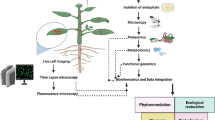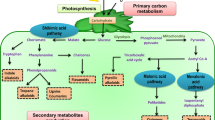Abstract
In the present work, Petunia × hybrida leaf discs maintained on regeneration medium for 8 days were used to assess the effects of genotoxic stress induced by in vitro culture. The investigation was carried out by comparing the response of intact leaves excised from Petunia × hybrida plantlets grown in vitro and the regenerating leaf discs. In situ detection by histochemical staining and alkaline-Single Cell Gel Electrophoresis (SCGE) analysis demonstrated that both reactive oxygen species accumulation and DNA damage were enhanced in explants cultured in vitro. Significant up-regulation of the PhOGG1 (8-oxoguanine DNA glycosylase/lyase), PhAPX (ascorbate peroxidase) and PhMT2 (metallothionein) genes involved in DNA repair and antioxidant defence was observed in the explants cultured in vitro, compared to intact leaves. The Petunia × hybrida leaf discs were exposed to increasing (0, 100, 150, 200 and 400 mM) doses of the model genotoxic agent hydrogen peroxide (H2O2) and then analysed. The DNA diffusion assay highlighted the dose- and time-dependent fluctuations of programmed cell death/necrosis events in response to H2O2. Leaf discs treated with increasing H2O2 concentration and untreated controls were analysed by FPG-SCGE to assess the level of oxidative DNA damage at different time points following treatments. The PhOGG1, PhAPX and PhMT2 genes were significantly up-regulated in response to H2O2, reaching the highest transcript levels with the 150 mM dose. Based on the reported data, these genes might be used as molecular indicators of the genotoxic stress response in Petunia × hybrida cells.




Similar content being viewed by others
Abbreviations
- APX:
-
Ascorbate peroxidase
- BA:
-
Benzyladenine
- BER:
-
Base excision repair
- DAB:
-
3,3′-Diaminobenzidine
- DAPI:
-
4′,6-Diamino-2-phenylindole
- DSB:
-
Double strand break
- FPG:
-
Formamidopyrimidine-DNA glycosylase
- MT:
-
Metallothionein
- 8-oxo-Dg:
-
7, 8-Dihydro-8-oxoguanine
- Ph:
-
Petunia × hybrida
- NBT:
-
Nitroblue tetrazolium
- PCD:
-
Programmed cell death
- OGG1:
-
8-Oxoguanine DNA glycosylase/lyase
- QRT-PCR:
-
Quantitative real-time polymerase chain reaction
- ROS:
-
Reactive oxygen species
- SCGE:
-
Single cell gel electrophoresis
- SSB:
-
Single strand break
References
Angenent GC, Stuurman J, Snowden KC, Koes R (2005) Use of Petunia to unravel plant meristem functioning. Trends Plant Sci 10:243–250
Balestrazzi A, Botti S, Zelasco S, Biondi S, Franchin C, Calligari P, Racchi M, Turchi A, Lingua G, Berta G, Carbonera D (2009) Expression of the PsMT A1 gene in white poplar engineered with the MAT system is associated to heavy metal tolerance and protection against 8-hydroxy-2′-deoxyguanosine mediated-DNA damage. Plant Cell Rep 28:1179–1192
Balestrazzi A, Confalonieri M, Macovei A, Carbonera D (2010) Seed imbibition in Medicago truncatula Gaertn.: expression profiles of DNA repair genes in relation to PEG-mediated stress. J Plant Physiol 168:706–713
Balestrazzi A, Confalonieri M, Macovei A, Donà M, Carbonera D (2011a) Genotoxic stress and DNA repair in plants: emerging functions and tools for improving crop productivity. Plant Cell Rep 30:287–295
Balestrazzi A, Agoni V, Tava A, Avato P, Biazzi E, Raimondi E, Macovei A, Carbonera D (2011b) Cell death induction and nitric oxide biosynthesis in white poplar (Populus alba L.) suspension cultures exposed to alfalfa saponins. Physiol Plant 141:227–238
Balestrazzi A, Macovei A, Tava A, Avato P, Raimondi E, Carbonera D (2011c) Unraveling the response of plant cells to cytotoxic saponins: role of metallothionein and nitric oxide. Plant Sign Behav 6:1–4
Balestrazzi A, Confalonieri M, Macovei A, Donà M, Carbonera D (2012) Genotoxic stress, DNA repair and crop productivity. In: Tuteja N, Gill SS (eds) Crop improvement under adverse conditions. Springer, Berlin/Heidelberg, pp 153–170
Brunner AM, Yakovlev IA, Strauss SH (2004) Validating internal controls for quantitative plant gene expression studies. BMC Plant Biol 4:14
Cassels AC, Curry RF (2001) Oxidative stress and physiological, epigenetic and genetic variability in plant tissue culture: implications for micropropagation and genetic engineering. Plant Cell Tissue Org Cult 64:145–157
Collins AR (2004) The comet assay for DNA damage and repair. Mol Biotech 26:249–261
Dimova EG, Bryant PE, Chankova SG (2008) ‘Adaptive response’-some underlying mechanisms and open questions. Gen Mol Biol 31:396–408
Donà M, Ventura L, Macovei A, Confalonieri M, Savio M, Giovannini A, Carbonera D, Balestrazzi A (2013) Gamma irradiation with different dose rates induces different DNA damage responses in Petunia × hybrida cells. J Plant Physiol 170:780–787
Freisinger E (2011) Structural features specific to plant metallothioneins. J Biol Chem 16:1035–1045
Fryer MJ, Oxborough K, Mullineaux PM, Baker NR (2002) Imaging of photooxidative stress responses in leaves. J Exp Bot 53:1249–1254
Gerats T, Vandenbussche M (2005) A model system for comparative research: petunia. Trends Plant Sci 10:251–256
Gichner T, Mukherjee A, Wagner ED, Plewa MJ (2005) Evaluation of the nuclear DNA diffusion assay to detect apoptosis and necrosis. Mutat Res 586:38–46
Gill SS, Tuteja N (2010) Reactive oxygen species and antioxidant machinery in abiotic stress tolerance in crop plants. Plant Physiol Biochem 48:909–930
Giovannini A, Nicoletti F, Dente F, Balestrazzi A, Donà M, Macovei A, Carbonera D, Ventura L, Buttafava A, Langella R, Albani M (2012) Mutation breeding for improving ornamental traits in commercial micropropagated varietes. Acta Italus Hortus 4:72–75
Girard PM, Guibourt N, Boiteux S (1997) The OGG1 protein of Saccharomyces cerevisiae: a 7,8-dihydro-8-oxoguanine DNA glycosylase/AP lyase whose lysine 241 is a critical residue from catalytic activity. Nucleic Acids Res 25:3204–3211
Hassinen VH, Tervahanta AI, Schat H, Karenlampi SO (2010) Plant metallothioneins—metal chelators with ROS scavenging activity. Plant Biol 13:225–232
Hogg BV, Kacprzyk J, Molony EM, O’Reilly C, Gallagher TF, Gallois P, McCabe PF (2011) An in vitro root hair assay for determining rates of apoptotic-like programmed cell death in plants. Plant Methods 7:45
Ishikawa T, Shigeoka S (2008) Recent advances in ascorbate biosynthesis and the physiological significance of ascorbate peroxidase in photosynthesizing organisms. Biosci Biotech Biochem 72:1143–1154
Jain SM (2010) Mutagenesis in crop improvement under the climate change. Rom Biotech Lett 15:88–106
Kakar K, Wandrey M, Czechowski T, Gaertner T, Scheible WR, Stitt M, Torres-Jerez I, Xiao Y, Redman J, Wu HC, Cheung F, Town CD, Udvardi MK (2008) A community resource for high-throughput quantitative RT-PCR analysis of transcription factor gene expression in Medicago truncatula. Plant Methods 4:18
Larkin JP, Scowcroft WR (1981) Somaclonal variation—a novel source of variability from cell cultures for plant improvement. Theoret Appl Genet 60:197–214
Macovei A, Balestrazzi A, Confalonieri M, Carbonera D (2010) The Tdp1 (tyrosyl-DNA phosphodiesterase) gene family in Medicago truncatula Gaertn.: bioinformatic investigation and expression profiles in response to copper- and PEG-mediated stress. Planta 232:393–407
Macovei A, Balestrazzi A, Confalonieri M, Faè M, Carbonera D (2011a) New insights on the barrel medic MtOGG1 and MtFPG functions in relation to oxidative stress response in planta and during seed imbibition. Plant Physiol Biochem 49:1040–1050
Macovei A, Balestrazzi A, Confalonieri M, Buttafava A, Carbonera D (2011b) The TFIIS and TFIIS-like genes from Medicago truncatula are involved in oxidative stress response. Gene 470:20–30
McKim S, Hay A (2010) Patterning and evolution of floral structures-marking time. Curr Opin Genet Dev 20:448–453
Menke M, Meister A, Schubert I (2000) N-methyl-N-nitrosourea-induced DNA damage detected by the comet assay in Vicia faba nuclei during interphase stages is not restricted to chromatid aberration hotspots. Mutagenesis 15:503–506
Murashige T, Skoog F (1962) A revised medium for rapid growth and bioassays with tobacco tissue culture. Physiol Plant 15:73–79
Murphy TM, George A (2005) A comparison of two DNA base excision repair glycosylases from Arabidopsis thaliana. Biochem Biophy Res Commu 329:869–872
Pages V, Fuchs RPP (2002) How DNA lesions are turned into mutations within cells? Oncogene 21:8957–8966
Pasternak TP, Prinsen E, Ayaydin F, Miskolczi P, Potters G, Asard H, Vanonckelen HA, Dudits D, Feher A (2000) The role of auxin, pH, and stress in the activation of embryogenic cell division in leaf protoplast-derived cells of alfalfa. Plant Physiol 129:1807–1819
Ramakers C, Ruijter JM, Lekanne Deprez RH, Moorman AFM (2003) Assumption-free analysis of quantitative real-time polymerase chain reaction (PCR) data. Neurosci Lett 339:62–66
Reape TJ, McCabe PF (2010) Apoptotic-like regulation of programmed cell death in plants. Apoptosis 15:249–256
Roldan-Arjona T, Ariza RR (2009) Repair and tolerance of oxidative DNA damage in plants. Mutat Res 681:169–179
Sanderson RJ, Mobaugh DW (1998) Fidelity and mutational specificity of uracil-initiated base excision DNA repair synthesis in human glioblastoma cell extracts. J Biol Chem 273:24822–24831
Sato M, Hosokawa M, Doi M (2011) Somaclonal variation is induced de novo via the tissue culture process: a study quantifying mutated cells in Saintpaulia. PLoS ONE 6:e23541
Shu QY (2009) Turning plant mutation into a new era: molecular mutation breeding. Induced plant mutations in the genomic era. FAO, Rome, pp 425–427
Singh NP (2000) A simple method for accurate estimation of apoptotic cells. Exp Cell Res 256:328–337
Singh NP (2003) Apoptosis by DNA diffusion assay. In: Blumenthal R (ed) Methods in molecular medicine-chemiosensitivity. Humana Press, New York, pp 78–94
Singh NP (2005) Apoptosis assessment by the DNA diffusion assay. Methods Mol Med 111:55–67
Stavreva DA, Gichner T (2002) DNA damage induced by hydrogen peroxide in cultured tobacco cells is dependent on the cell growth stage. Mutation Res 514:147–152
Thordal-Christensen H, Zhang Z, Wei Y, Collinge DB (1997) Subcellular localization of H2O2 in plants. H2O2 accumulation in papillae and hypersensitive response during the barley-powdwry mildew interaction. Plant J 11:1187–1194
Ventura L, Donà M, Macovei A, Carbonera D, Buttafava A, Mondoni A, Rossi G, Balestrazzi A (2012) Understanding the molecular pathways associated with seed vigor. Plant Physiol Biochem 60:196–206
Wessels A, Van Berlo D, Boots AW, Gerloff K, Van Shooten FJ, Albrecht C, Schins RP (2011) Oxidative stress and DNA damage responses in rat and mouse lung to inhaled carbon nanoparticles. Nanotoxicol 5:66–78
Yamamoto Y, Kobayashi Y, Devis R, Rkiishi S, Matsumoto H (2001) Aluminum toxicity is associated with mitochondrial disfunction and the production of reactive oxygen species in plant cells. Plant Physiol 128:63–72
Zielinska A, Davies OT, Meldrum RA, Hodges NJ (2011) Direct visualization of repair of oxidative damage by OGG1 in the nucleus of live cells. J Biochem Mol Toxicol 25:1–7
Acknowledgments
Authors would like to thank Dr. Raffaele Langhella and Albani Vincenzo e Ruggeri Italina s.s.a., via Fontanatetta 158, 00053 Civitavecchia (RO) for supplying the P. × hybrida genotype. This research was supported by the ‘MUTAFLOR’ project from the Italian Ministry of Agriculture-MiP.A.F.
Author information
Authors and Affiliations
Corresponding author
Additional information
Communicated by Y. Wang.
Rights and permissions
About this article
Cite this article
Ventura, L., Macovei, A., Donà, M. et al. Genotoxic effects due to in vitro culture and H2O2 treatments in Petunia × hybrida cells monitored through DNA diffusion assay, FPG-SCGE and gene expression profile analyses. Acta Physiol Plant 36, 331–341 (2014). https://doi.org/10.1007/s11738-013-1415-6
Received:
Revised:
Accepted:
Published:
Issue Date:
DOI: https://doi.org/10.1007/s11738-013-1415-6




